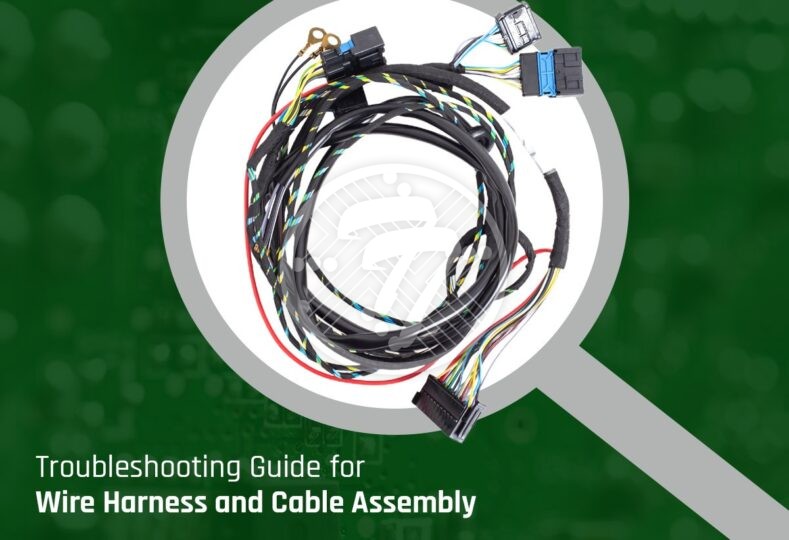The Troubleshooting Guide for Wire Harness and Cable Assembly

While the term cable assembly and wire harness are often used interchangeably, these are two distinct products that have different uses.
A wire harness typically consists of multiple wires within an exterior sheath. The exterior sheath is made up of thermoplastic or thermoset and does not offer too much protection from friction or temperature fluctuation. Wire harnesses, therefore, do not find extensive application in harsh and demanding environments. Cable assemblies, on the other hand, also have multiple wires covered by an external sheath, however the sheath is made up of heavy-duty material that can withstand environmental pressures. Explore the top difference between cable assembly and wire harness.
Below are some of the problems faced in cable assemblies and wire harnesses; and effective troubleshooting methods for them:
Common Problems faced with Wire Harnesses Assemblies:
- Not making the right choice of cable – Very often the underperformance or failure of the cable assembly is on account of their inappropriate selection given the environment they must function in. For instance, if the cable isn’t durable enough to withstand force, they could break. In such cases, a pull test is required to figure out its strength.
- Improper Installation – Incorrect installation of cable assembly can impact their performance. Whether it is a sloppy soldering job or if the die is set incorrectly, it is bound to show deterioration.
- Testing not done correctly – Post assembly of the cable component, if the testing isn’t done correctly, it can lead to issues that can turn out to be costly in the long run.
Common Problems faced with Wire Harnesses:
- Improper Wire Preparation – Wire Preparation involves stages such as the right selection of wire, cutting it correctly. Any of this not done correctly can lead to incorrectly prepared components.
- Improper layout – The wires need to be arranged properly so that they fit into the harness.
- Improper labeling – Especially when harnesses are mass produced, improper labeling can lead to a range of issues.
- Crimping and defects related to soldering – These can lead to issues related to the circuit.
- Missing Components- This can lead to harness failure. It is imperative, therefore that the assembly documentation is double-checked.
- Improper wire tying- Both tying the wires too tightly and tying them loosely can come with its own set of problems.
Intermittent Errors in Cable Assemblies and Wire Harnesses:
Common intermittent errors in cable harnesses and wire assemblies manufacturing process include:
- Opens
- Shorts
- Mis wired
These can be on account of a wide range of issues such as:
- Poor setup
- Weak contact
- Pin not seated correctly
- Damaged Housing
- Worn or dirty contacts
Despite all possible efforts undertaken to ensure there are no errors in cable assemblies and wire harnesses, inadvertent errors can still creep in. To avoid this, it is important to test the components thoroughly. Some of the common testing mechanisms include:
Mechanical Testing
This ensures that the mechanical properties are tested to see that they meet the requirement of the application. Some of the mechanical properties to be tested include:
- Elongation
- Tensile Strength
- Flexibility
- Impact resistance
- Cycles to failure, and more
Environmental Testing
This primarily involves testing to see that the cable assembly or wire harness can withstand environmental conditions such as:
- Humidity
- Temperature
- Vibration, and more
Electrical Testing
The electrical testing largely involves testing for:
- Open Wires
- Incorrect Wiring
- Risk of shorts
Visual Testing
Visual testing involves looking for all components and ascertaining if they are in good condition. Some of the aspects to watch out for, include:
- The wires and cables, their placement and whether there is any damage.
- Whether the connectors are proper.
- Whether the labeling has been done accurately.
Signal Integrity Testing
This involves assessing the signals that the cable assembly or wire harness can carry. You also need to check for crosstalk and signal errors. Also, it is important to see if the use of connectors, filters etc. ensures that signal strength can be maintained.
A judicious use of both the troubleshooting mechanisms as well as robust testing practices will ensure that you do not face performance issues with cable assemblies and wire harnesses.
Being a leading PCB manufacturer from past over 40 years, Technotronix is providing wire harness and cable assembly services in USA. It ranges from simple to every complex cable and wire harness assembly with quick turnaround time. Technotronix is specialized in layout and assembling of custom and complex cable and wire harness assemblies to address the needs of customers. We cater to the wide spread needs of our broad customer base of varied industries like aerospace, defense, telecommunication, medical etc.
For more information, get a quick wire harness and cable assembly quote or contact us via email at [email protected] or call us on 714/630-9200.






